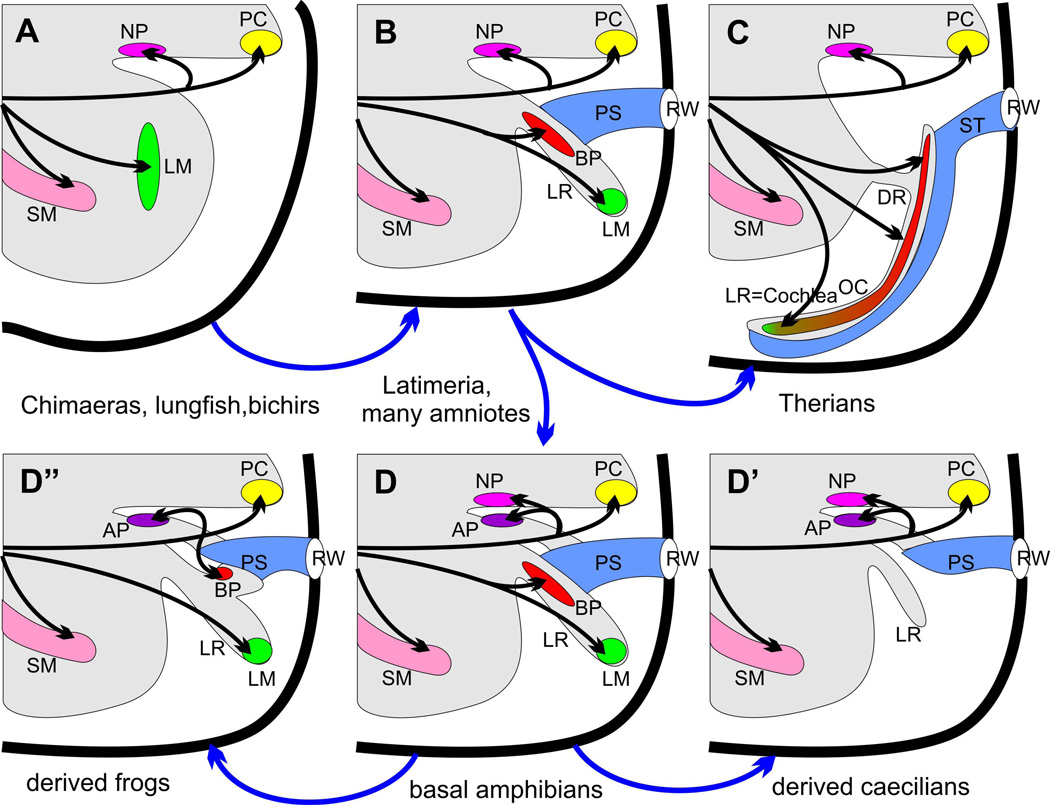Figure 2.
This diagram displays the basic changes in the posterior part of the ear in the sarcopterygian lineage. The plesiomorphic organization or shared primitive pattern (A) is found in lungfish, basal actinopterygians (polypteriformes, holocephalens, chondrosteans, holosteans) and basal Chondrichthyes (chimaeras). The characteristic features are the presence of a nerve branch of the fibers to the posterior canal crista (PC) extending to the neglected papilla (NP), a separate nerve twig going to the distinct lagenar macula (LM) in the saccular recess posterior to the saccular macula (SM). Note that there appears to be no opening other than for nerves in the otic capsule (bold line) and no specialization of the perilymphatic space enabling pressure differences to generate relative movements between sensory epithelia and their extracellular covering (otoconia, cupula). The derived condition (B) is found in Latimeria and amniotes, excluding therian mammals. The derived condition is characterized by the formation of a lagenar recess (LR), translocation of the lagenar macula (LM) into the lagenar recess, formation of the basilar papilla (BP) at the orifice of the lagenar recess, and the formation of a perilymphatic sac (PS) that connects the basilar papilla functionally with an opening in the otocyst wall, the round window (RW). Note that the innervation of the basilar papilla is via a nerve branch coming off the lagenar macula innervation. Further derived from this basic tetrapod condition are basic amphibians (many caecilians) through the formation of a recess for the amphibian papilla (AP) and the translocation of a part of the neglected papilla into this unique recess as an amphibian papilla (D). Salamanders and frogs have all lost the neglected papilla (D”) and most salamanders and all frogs have evolved a second recess from the lagenar recess that contains the basilar papilla thus generating the derived conditions of two saccular recesses (in addition to the lagenar recess) each with its own sensory epithelium (amphibian and basilar papilla). Note also that the derived condition of innervation for the basilar papilla is via a nerve coming off the nerve to the posterior canal crista that can be reconciled through intermediates. Finally, loss of the lagenar macula occurred independently in therian mammals where the anlage might have become incorporated into the elongated basilar papilla now referred to as the organ of Corti (green tip of the red basilar papilla) due to its unique organization of hair cells (C), which is connected via narrow canal, the ductus reuniens (DR) to the saccular recess (D’). Loss of lagenar macula also occurred in some caecilians where both the basilar papilla and the lagenar macula are lost (D’) but a short lagenar recess is retained. Modified after (Lewis et al. 1985; Fritzsch and Wake 1988; Fritzsch 1992).

